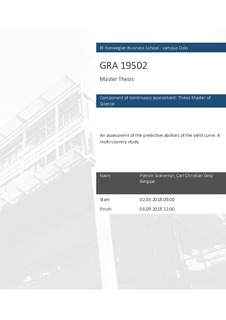| dc.contributor.author | Svanemyr, Patrick | |
| dc.contributor.author | Bergsjø, Carl Christian Delp | |
| dc.date.accessioned | 2019-01-09T13:19:45Z | |
| dc.date.available | 2019-01-09T13:19:45Z | |
| dc.date.issued | 2018 | |
| dc.identifier.uri | http://hdl.handle.net/11250/2579997 | |
| dc.description | Masteroppgave(MSc) in Master of Science in Business, Finance - Handelshøyskolen BI, 2018 | nb_NO |
| dc.description.abstract | In this thesis we assess the yield curve’s predictive abilities for the eight countries
in which OECD apply the interest rate spread as a part of their leading indicator
index. We develop a dynamic model that uses the yield curve and a recession lag
to predict recessions. The model is tested both in-sample and pseudo out-ofsample.
Our findings indicate that the yield curve still serve as a leading indicator
in some of the countries, but that OECD should revise its inclusion for some of
the other countries. The study differentiates itself from other studies assessing the
yield curve’s predictive abilities by that we assess the relationship for different
time periods, and we find that the yield curve’s significance has weakened over
the last two to three decades. The weakening of the yield curve’s predictive
abilities coincides with the growing awareness and focus on it as a leading
indicator of recessions. Our research discusses an eminent, but little discussed,
feature of research on the predictive abilities of the yield curve; that it fails to
predict the onset of recessions. The thesis highlights the need for further research
on several types of yield spreads and different types of recession indicators. | nb_NO |
| dc.language.iso | eng | nb_NO |
| dc.publisher | Handelshøyskolen BI | nb_NO |
| dc.subject | finans | nb_NO |
| dc.subject | finance | nb_NO |
| dc.title | An assessment of the predictive abilities of the yield curve: A multi-country study | nb_NO |
| dc.type | Master thesis | nb_NO |

